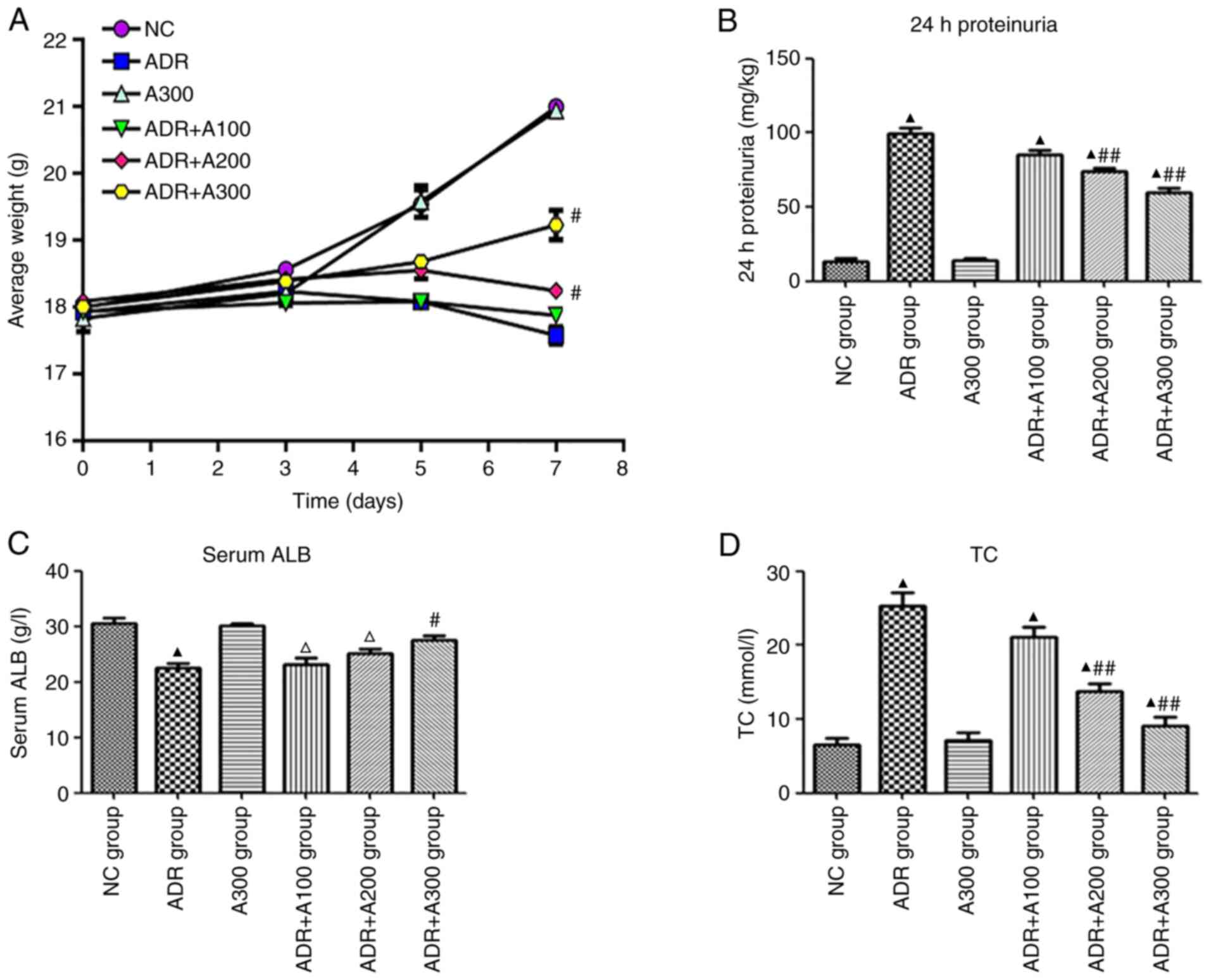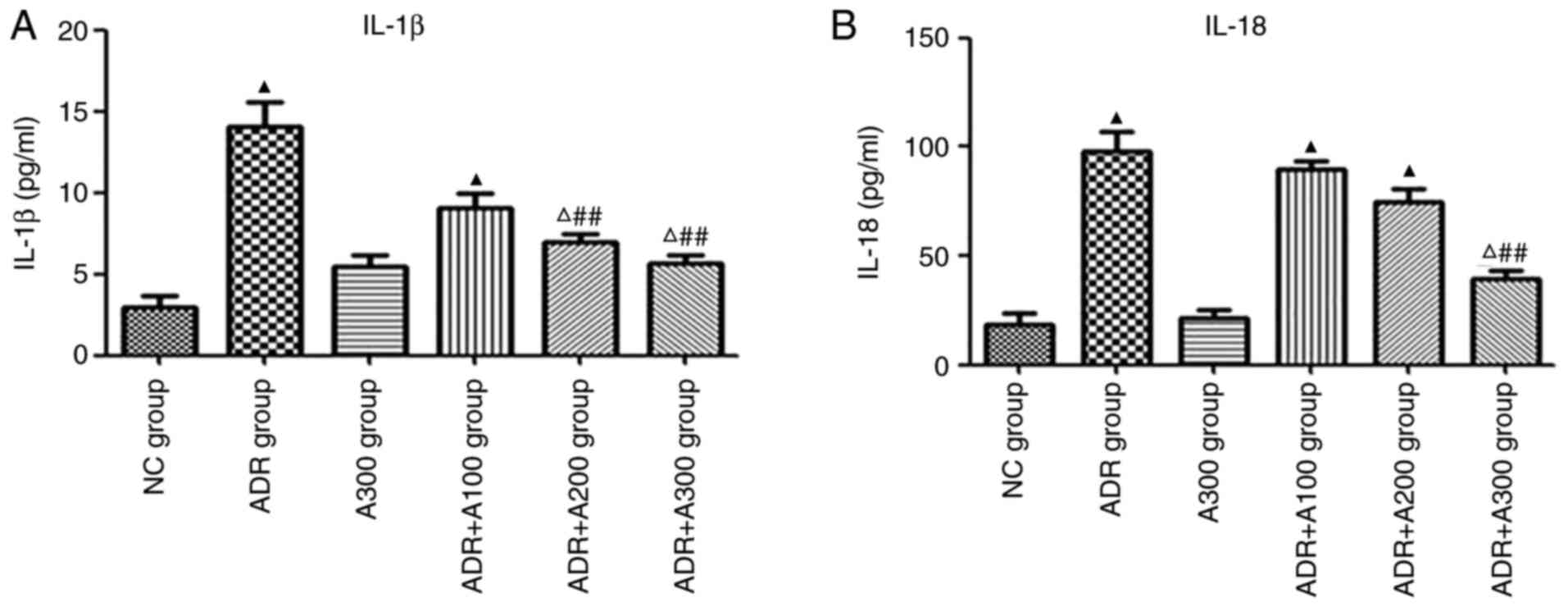|
1
|
Hao S, Wu Y, Kang Y, Niu X, Zhu G and
Huang W: A single-center analysis of primary nephrotic syndrome
with acute pancreatitis in children. Medicine (Baltimore).
99(e21056)2020.PubMed/NCBI View Article : Google Scholar
|
|
2
|
Chen A, Sheu LF, Ho YS, Lin YF, Chou WY,
Chou TC and Lee WH: Experimental focal segmental glomerulosclerosis
in mice. Nephron. 78:440–452. 1998.PubMed/NCBI View Article : Google Scholar
|
|
3
|
Manabe N, Kinoshita A, Yamaguchi M, Furuya
Y, Nagano N, Yamada-Uchio K, Akashi N, Miyamoto-Kuramitsu K and
Miyamoto H: Changes in quantitative profile of extracellular matrix
components in the kidneys of rats with adriamycin-induced
nephropathy. J Vet Med Sci. 63:125–133. 2001.PubMed/NCBI View Article : Google Scholar
|
|
4
|
Lydia A, Asanuma K, Nonaka K, Takagi M,
Jeong KH, Kodama F, Asao R, Asanuma E, Prodjosudjadi W and Tomino
Y: Effects of 22-oxa-calcitriol on podocyte injury in
adriamycin-induced nephrosis. Am J Nephrol. 35:58–68.
2012.PubMed/NCBI View Article : Google Scholar
|
|
5
|
Wang YM, Wang Y, Harris DCH, Alexander SI
and Lee VWS: Adriamycin nephropathy in BALB/c mice. Curr Protoc
Immunol. 108:15.28.1–15.28.6. 2015.PubMed/NCBI View Article : Google Scholar
|
|
6
|
Adinolfi E, Giuliani AL, De Marchi E,
Pegoraro A, Orioli E and Di Virgilio F: The P2X7 receptor: A main
player in inflammation. Biochem Pharmacol. 151:234–244.
2018.PubMed/NCBI View Article : Google Scholar
|
|
7
|
Jiang LH, Baldwin JM, Roger S and Baldwin
SA: Insights into the molecular mechanisms underlying mammalian
P2X7 receptor functions and contributions in diseases, revealed by
structural modeling and single nucleotide polymorphisms. Front
Pharmacol. 4(55)2013.PubMed/NCBI View Article : Google Scholar
|
|
8
|
Arkhipov SN and Pavlov TS: ATP release
into ADPKD cysts via pannexin-1/P2X7 channels decreases ENaC
activity. Biochem Biophys Res Commun. 513:166–171. 2019.PubMed/NCBI View Article : Google Scholar
|
|
9
|
Wang C, Hou XX, Rui HL, Li LJ, Zhao J,
Yang M, Sun LJ, Dong HR, Cheng H and Chen YP: Artificially
cultivated ophiocordyceps sinensis alleviates diabetic nephropathy
and its podocyte injury via inhibiting P2X7R expression and NLRP3
inflammasome activation. J Diabetes Res.
2018(1390418)2018.PubMed/NCBI View Article : Google Scholar
|
|
10
|
Franco M, Bautista-Pérez R, Cano-Martínez
A, Pacheco U, Santamaría J, Del Valle Mondragón L, Pérez-Méndez O
and Navar LG: Physiopathological implications of P2X1 and P2X7
receptors in regulation of glomerular hemodynamics in angiotensin
II-induced hypertension. Am J Physiol Renal Physiol. 313:F9–F19.
2017.PubMed/NCBI View Article : Google Scholar
|
|
11
|
Koo TY, Lee JG, Yan JJ, Jang JY, Ju KD,
Han M, Oh KH, Ahn C and Yang J: The P2X7 receptor antagonist,
oxidized adenosine triphosphate, ameliorates renal
ischemia-reperfusion injury by expansion of regulatory T cells.
Kidney Int. 92:415–431. 2017.PubMed/NCBI View Article : Google Scholar
|
|
12
|
Harada H, Chan CM, Loesch A, Unwin R and
Burnstock G: Induction of proliferation and apoptotic cell death
via P2Y and P2X receptors, respectively, in rat glomerular
mesangial cells. Kidney Int. 57:949–958. 2000.PubMed/NCBI View Article : Google Scholar
|
|
13
|
Sha W, Shen L, Zhou L, Xu DY and Lu GY:
Down-regulation of miR-186 contributes to podocytes apoptosis in
membranous nephropathy. Biomed Pharmacother. 75:179–184.
2015.PubMed/NCBI View Article : Google Scholar
|
|
14
|
Beaucage KL, Xiao A, Pollmann SI, Grol MW,
Beach RJ, Holdsworth DW, Sims SM, Darling MR and Dixon SJ: Loss of
P2X7 nucleotide receptor function leads to abnormal fat
distribution in mice. Purinergic Signal. 10:291–304.
2014.PubMed/NCBI View Article : Google Scholar
|
|
15
|
Peng K, Liu L, Wei D, Lv Y, Wang G, Xiong
W, Wang X, Altaf A, Wang L, He D, et al: P2X7R is involved in the
progression of atherosclerosis by promoting NLRP3 inflammasome
activation. Int J Mol Med. 35:1179–1188. 2015.PubMed/NCBI View Article : Google Scholar
|
|
16
|
Wang C, Li Q, Zhen J, Xu Y and Sun S:
Simvastatin ameliorates renal lipidosis through the suppression of
renal CXCL16 expression in mice with adriamycin-induced
nephropathy. Int J Clin Exp Pathol. 8:15696–15707. 2015.PubMed/NCBI
|
|
17
|
Gauckler P, Shin JI, Alberici F, Audard V,
Bruchfeld A, Busch M, Cheung CK, Crnogorac M, Delbarba E, Eller K,
et al: Rituximab in adult minimal change disease and focal
segmental glomerulosclerosis-what is known and what is still
unknown? Autoimmun Rev. 19(102671)2020.PubMed/NCBI View Article : Google Scholar
|
|
18
|
Gentile D, Natale M, Lazzerini PE,
Capecchi PL and Laghi-Pasini F: The role of P2X7 receptors in
tissue fibrosis: A brief review. Purinergic Signal. 11:435–440.
2015.PubMed/NCBI View Article : Google Scholar
|
|
19
|
Vonend O, Turner CM, Chan CM, Loesch A,
Dell'Anna GC, Srai KS, Burnstock G and Unwin RJ: Glomerular
expression of the ATP-sensitive P2X receptor in diabetic and
hypertensive rat models. Kidney Int. 66:157–166. 2004.PubMed/NCBI View Article : Google Scholar
|
|
20
|
Mansouri E, Assarehzadegan MA,
Nejad-Dehbashi F and Kooti W: Effects of Pravastatin in
adriamycin-induced nephropathy in rats. Iran J Pharm Res.
17:1413–1419. 2018.PubMed/NCBI
|
|
21
|
Lee VW and Harris DC: Adriamycin
nephropathy: A model of focal segmental glomerulosclerosis.
Nephrology (Carlton). 16:30–38. 2011.PubMed/NCBI View Article : Google Scholar
|
|
22
|
Lee HS: Oxidized LDL, glomerular mesangial
cells and collagen. Diabetes Res Clin Pract. 45:117–122.
1999.PubMed/NCBI View Article : Google Scholar
|
|
23
|
Korhonen M, Ylänne J, Laitinen L and
Virtanen I: The alpha 1-alpha 6 subunits of integrins are
characteristically expressed in distinct segments of developing and
adult human nephron. J Cell Biol. 111:1245–1254. 1990.PubMed/NCBI View Article : Google Scholar
|
|
24
|
Lee HS, Jeong JY, Kim BC, Kim YS, Zhang YZ
and Chung HK: Dietary antioxidant inhibits lipoprotein oxidation
and renal injury in experimental focal segmental
glomerulosclerosis. Kidney Int. 51:1151–1159. 1997.PubMed/NCBI View Article : Google Scholar
|
|
25
|
Zhang G, Li Q, Wang L, Chen Y, Zhang W and
Yang H: The effects of inflammation on lipid accumulation in the
kidneys of children with primary nephrotic syndrome. Inflammation.
34:645–652. 2011.PubMed/NCBI View Article : Google Scholar
|
|
26
|
Moorhead JF, Chan MK, El-Nahas M and
Varghese Z: Lipid nephrotoxicity in chronic progressive glomerular
and tubulo-interstitial disease. Lancet. 2:1309–1311.
1982.PubMed/NCBI View Article : Google Scholar
|
|
27
|
Vaziri ND, Navab M and Fogelman AM: HDL
metabolism and activity in chronic kidney disease. Nat Rev Nephrol.
6:287–296. 2010.PubMed/NCBI View Article : Google Scholar
|
|
28
|
Hu ZB, Chen Y, Gong YX, Gao M, Zhang Y,
Wang GH, Tang RN, Liu H, Liu BC and Ma KL: Activation of the
CXCL16/CXCR6 pathway by inflammation contributes to atherosclerosis
in patients with end-stage renal disease. Int J Med Sci.
13:858–867. 2016.PubMed/NCBI View Article : Google Scholar
|
|
29
|
Di Virgilio F: The therapeutic potential
of modifying inflammasomes and NOD-like receptors. Pharmacol Rev.
65:872–905. 2013.PubMed/NCBI View Article : Google Scholar
|
|
30
|
Ogura Y, Sutterwala FS and Flavell RA: The
inflammasome: First line of the immune response to cell stress.
Cell. 126:659–662. 2006.PubMed/NCBI View Article : Google Scholar
|
|
31
|
Turner CM, Tam FW, Lai PC, Tarzi RM,
Burnstock G, Pusey CD, Cook HT and Unwin RJ: Increased expression
of the pro-apoptotic ATP-sensitive P2X7 receptor in experimental
and human glomerulonephritis. Nephrol Dial Transplant. 22:386–395.
2007.PubMed/NCBI View Article : Google Scholar
|
|
32
|
Eamshaw WC, Martins LM and Kaufinann SH:
Mammalian caspases: Structure, activation, substrates, and
functions during apoptosis. Annu Rev Biochem. 68:383–424.
1999.PubMed/NCBI View Article : Google Scholar
|
|
33
|
Zhang Y, Yuan F, Cao X, Zhai Z, Huang G,
Du X, Wang Y, Zhang J, Huang Y, Zhao J and Hou W: P2X7 receptor
blockade protects against cisplatin-induced nephrotoxicity in mice
by decreasing the activities of inflammasome components, oxidative
stress and caspase-3. Toxicol Appl Pharmacol. 281:1–10.
2014.PubMed/NCBI View Article : Google Scholar
|
|
34
|
Liu L, Yang L, Chang B, Zhang J, Guo Y and
Yang X: The protective effects of rapamycin on cell autophagy in
the renal tissues of rats with diabetic nephropathy via
mTOR-S6K1-LC3II signaling pathway. Ren Fail. 40:492–497.
2018.PubMed/NCBI View Article : Google Scholar
|

















